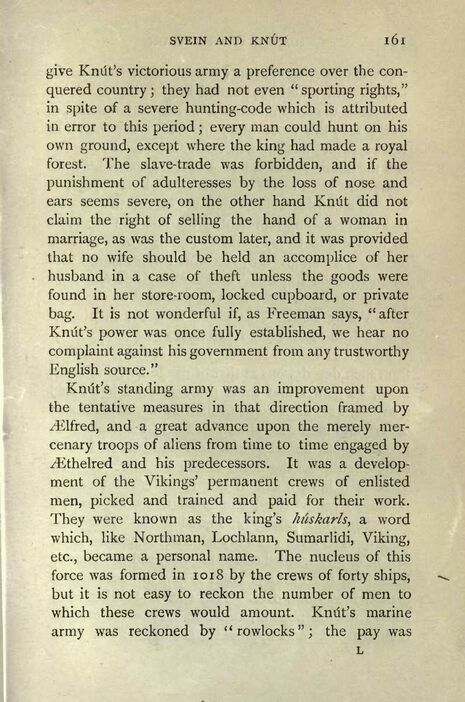
Full resolution (JPEG) - On this page / på denna sida - Scandinavian Britain - II. The Danelaw - 5. Svein and Knút

<< prev. page << föreg. sida << >> nästa sida >> next page >>
Below is the raw OCR text
from the above scanned image.
Do you see an error? Proofread the page now!
Här nedan syns maskintolkade texten från faksimilbilden ovan.
Ser du något fel? Korrekturläs sidan nu!
This page has been proofread at least once.
(diff)
(history)
Denna sida har korrekturlästs minst en gång.
(skillnad)
(historik)
give Knút’s victorious army a preference over the conquered
country; they had not even "sporting rights,"
in spite of a severe hunting-code which is attributed
in error to this period ; every man could hunt on his
own ground, except where the king had made a royal
forest. The slave-trade was forbidden, and if the
punishment of adulteresses by the loss of nose and
ears seems severe, on the other hand Knút did not
claim the right of selling the hand of a woman in
marriage, as was the custom later, and it was provided
that no wife should be held an accomplice of her
husband in a case of theft unless the goods were
found in her store-room, locked cupboard, or private
bag. It is not wonderful if, as Freeman says, "after
Knút’s power was once fully established, we hear no
complaint against his government from any trustworthy
English source."
Knút’s standing army was an improvement upon
the tentative measures in that direction framed by
Ælfred, and a great advance upon the merely mercenary
troops of aliens from time to time engaged by
Æthelred and his predecessors. It was a development
of the Vikings’ permanent crews of enlisted
men, picked and trained and paid for their work.
They were known as the king’s húskarls a word
which, like Northman, Lochlann, Sumarlidi, Viking,
etc., became a personal name. The nucleus of this
force was formed in 1018 by the crews of forty ships,
but it is not easy to reckon the number of men to
which these crews would amount. Knút’s marine
army was reckoned by "rowlocks"; the pay was
<< prev. page << föreg. sida << >> nästa sida >> next page >>